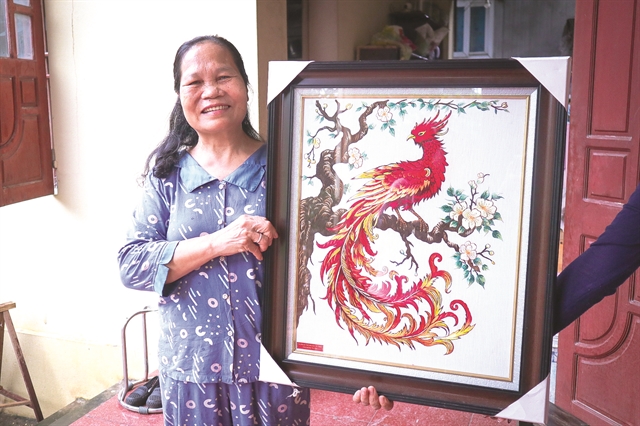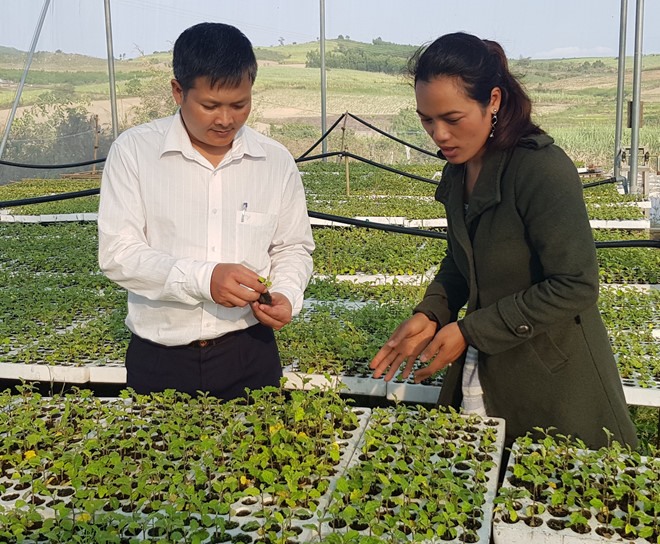 Features
Features

Following the trend of coming back to the nature, young nature lovers have made use of available sources of raw materials in their homeland to develop local products with high economic values and health benefits
 |
| Lương Thị Diễm Trinh carefully selects flowers from her garden. Photo dantri.com.vn |
ĐỒNG THÁP — Born and raised in Sa Đéc City in the Mekong Delta province of Đồng Tháp, Lương Thị Diễm Trinh fell in love with flowers at a young age.
Interested in pharmaceuticals, Trinh studied medical journals to see how flowers can be used by herbalists.
The idea of making tea from flowers came to her in 2016 after she realised she could make use of fertiliser-free flowers from her family’s 1,200sq.m garden. She invested in a drying machine and learnt recipes from books.
The biology and chemistry she had learned at college helped her a lot. She started with common flowers with small quantities like roses, just to serve to her relatives to enjoy.
The first flower tea products received positive feedback from Trinh’s family and friends. Realising more consumers were turning to nature-friendly products, Trinh decided to start making large quantities and develop her own brand.
She tried several flowers from đậu biếc (Clitoria ternatea), nguyệt quế (laurel flower) and đinh lăng (Polyscias fruticosa), to grapefruit peel and artichoke.
In 2017, she started selling her tea to the public.
According to Trinh, the advantage of her tea is that all her flowers are cultivated without the use of chemicals.
Trinh has also collaborated with other local gardeners to provide sources of clean flowers for her teas.
The tea-making process consists of picking the flowers, washing them, and drying them for three to eight hours at 65 to 70 degrees Celsius.
The flowers are then left to cool and packed in 50g bags to be sold for VNĐ40,000-70,000 (US$1.7-2.9). Ten kilos of fresh flowers can make 1kg of tea.
“At first I faced quite a lot of difficulties but I learnt from my mistakes,” she said.
The most important step is to select the right flowers.
Every day Trinh carefully selects every single flower from her garden. That’s the reason her tea has a special taste.
“Sa Đéc Village has hundreds of types of flowers but not all of them can be used to make tea,” she said.
“Other tea makers use rosebuds but I choose roses in early bloom. Rosebuds look good and don’t get damaged during transport. Tea drinkers must filter tea made from rosebuds to fully enjoy the taste.
“My customers are mostly young office workers who want to enjoy a cup of tea by just adding boiling water. Tea made from roses in early bloom satisfies their demand to enjoy a quick cup of tea with a strong and pleasant taste.”
Trinh’s is not available in Sa Đéc City and other localities and also online.
Trinh, also a biology teacher at a local secondary school, want to teach her students both theoretical and practical knowledge.
“I want my students to understand more about flowers so that in the future they can do something for their village,” she said.
Her project has received a food safety certificate, brand registration and a business licence from Tân Quy Tây Commune’s Women’s Association. Local authorities have also helped her to attend business courses to improve product quality and design for further development.
Lê Thị Ánh Quyên, vice president of Sa Đéc City’s Women’s Association, said they would offer her project support due to the fact Trinh’s had been selected as one of the start-up projects of the year.
Escaping poverty
 |
| Hồ Thị Viên checks cà gai leo seedlings. Photo thanhnien.vn |
Also taking advantage of local plants is Hồ Thị Viên, another young girl from the Central Highlands province of Gia Lai, who has helped ethnic minority people escape poverty.
Realising the economic value and health benefits to cure liver-related diseases of cà gai leo (Solanum procumbens), Viên asked for permission from local authorities to cultivate the plant in her village.
“For many years villagers have been using the plant to improve their health, so I came up with the idea of selling cà gai leo to make a profit,” she said.
Local authorities in Tú An Commune allocated nearly 2ha of land to Viên and other locals from 10 households to cultivate the plant.
Now 80,000 cà gai leo plants have been cultivated on the land.
Viên and other locals are thinking about using a sprinkler system to water the plants during the coming dry season.
It is estimated that cà gai leo yields up to 5 to 7 tonnes per hectare per year. The estimated investment for 1 ha is VNĐ15 million ($640) while one kilo of dried cà gai leo is sold to traders at VNĐ70,000.
Viên is thinking even bigger. She is looking forward to making tea and other organic products from cà gai leo to exploit more value from the plant.
Authorities in An Khê Town have helped Viên and other farmers to connect with a business in the north of Việt Nam for technical and consumption assistance.
Her start-up project is in the top 20 projects in the final round of applying for funds from the World Bank.
This has provided the motivation for Viên to study more about medicinal plants and cultivate them in her home town. VNS




